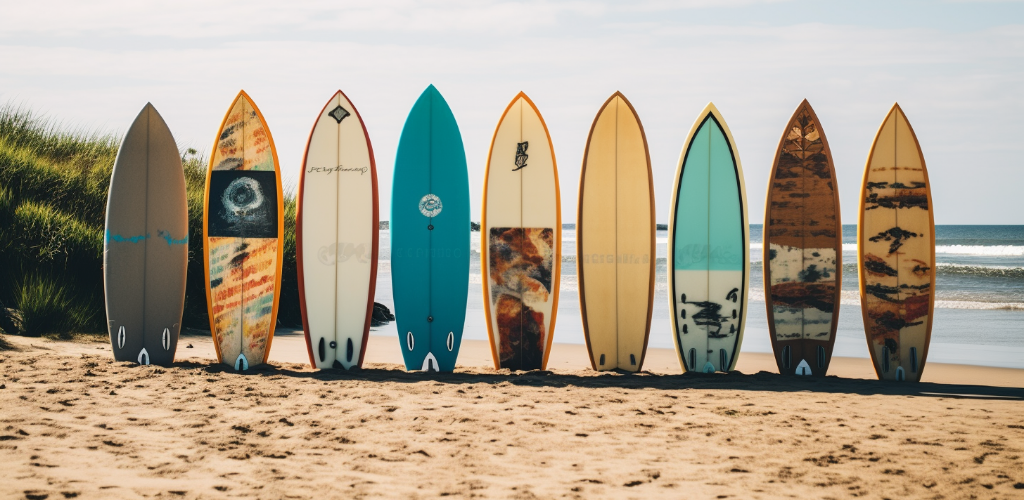Surfing, a beloved pastime enjoyed by millions worldwide, has a rich and fascinating history. Originating from the Polynesian islands, this thrilling water sport has evolved significantly over the centuries. Today, we have a myriad of surfboard types, each specifically designed to accommodate different wave conditions, surfing styles, and skill levels. This diversity in surfboard designs is a testament to the sport’s evolution and its continuous innovation.
From the ancient Hawaiians riding wooden planks to modern surfers carving waves on state-of-the-art boards, the surfboard is the surfer’s vital companion. It’s more than just a piece of equipment; it’s a tool that enables the surfer to interact with the ocean’s energy. But how do you choose the right surfboard? And why is it so important?
The Importance of Choosing the Right Surfboard
Choosing the right surfboard can make a significant difference in your surfing experience. A board that matches your skill level, body weight, and the type of waves you wish to surf can enhance your performance and enjoyment. Alternatively, a poorly chosen board can hinder your progress and even pose safety risks. Ever tried catching a fast-breaking wave with a longboard designed for slower, rolling waves? If so, you understand the struggle!
So, it’s crucial to understand the different types of surfboards and what they’re designed for to make an informed decision.
Basic Components of a Surfboard
Before we dive into the types of surfboards, let’s first understand the basic components of a surfboard. At first glance, a surfboard might look like a simple piece of equipment. However, its design is a complex blend of art and science, with each part serving a specific purpose.
The deck is the top surface of the board where the surfer stands. The nose is the front end, while the tail is the back end. The rails are the edges of the board, and the fins are the small rudders underneath the tail that provide stability and steering control. Each of these components plays a critical role in how the surfboard performs in the water.
Popular Types of Surfboards
Did you know that there are several types of surfboards, each designed with a specific purpose in mind? Yes, you read that right! Let’s take a closer look at some of the most popular ones.
Longboards
First up, we have the longboards. These boards, as their name suggests, are longer in length and have been around since the early days of surfing. They are known for their stability and are often recommended for beginners. Why, you ask? Well, their length and wide nose make it easier for newbies to balance and catch waves. The longboard is a versatile piece, ideal for small wave days but also capable of handling larger swells.
Shortboards
Next, we have the shortboards. These boards are smaller, lighter, and designed with a pointed nose. They are built for speed and agility, allowing surfers to perform quick maneuvers and ride the wave more aggressively. So, if you’re all about high-performance surfing and love the thrill of executing sharp turns and aerial tricks, shortboards might be your go-to choice.
Fish Surfboards
Let’s not forget about the fish surfboards. These boards have a unique design characterized by a wide, rounded nose and a swallowtail at the back. They are excellent for small to medium-sized waves. Their design allows the surfer to maintain speed even in weaker wave conditions. So, if you’re surfing in a place where the waves don’t get too big, a fish surfboard could be a great option.
Specialized Surfboards and their Uses
While the above-mentioned boards cover a wide range of surfing conditions and styles, there are also surfboards designed for very specific conditions or advanced surfing techniques. Let’s dive into some of these specialized boards.
Gun Surfboards
Ever heard of gun surfboards? These boards are specifically designed for big wave surfing. They are longer and narrower compared to other surfboards, allowing them to cut through the water and maintain stability at high speeds. If you’re an adrenaline junkie looking to ride some serious waves, a gun surfboard might be the one for you.
Hybrid Surfboards
Last but not least, we have the hybrid surfboards. These boards combine elements from different surfboard designs to offer a balance between stability and maneuverability. They are versatile and can be used in a variety of wave conditions. Whether you’re a beginner looking for a board that can grow with you as you improve, or an experienced surfer looking for a board that can handle different wave conditions, a hybrid surfboard could be an excellent choice.
Guide on Choosing the Right Surfboard
Have you ever found yourself overwhelmed by the variety of surfboards available in the market? Choosing the right surfboard can feel like a daunting task, especially for beginners. But don’t worry. It’s important to remember that selecting a surfboard is a highly personal decision, one that should be based on individual needs and preferences. Let’s break down some of the key factors that can guide you in making the best choice.
- Surfer’s skill level: Are you a beginner, intermediate, or advanced surfer? Your skill level greatly influences the type of surfboard you should go for. For instance, beginners might find longboards more suitable due to their stability.
- Height and weight: Your physical attributes such as height and weight also play a crucial role. Larger surfers may require a larger board for better buoyancy, while smaller surfers might find smaller boards easier to control.
- Preferred surfing style: Do you enjoy making quick maneuvers or do you prefer a steady, flowing style? Your surfing style can help determine whether you should go for a shortboard, longboard, or something in between.
- Wave conditions: Lastly, consider the type of waves you’ll be surfing most frequently. Certain boards perform better in specific wave conditions.
Maintaining Your Surfboard
After investing time and money in finding your ideal surfboard, you’d want it to last as long as possible, right? This is where proper maintenance comes into play. A well-maintained surfboard not only lasts longer but also performs better in the water. So, let’s dive into some tips on how to care for your prized possession.
First and foremost, cleaning your surfboard regularly is crucial. Saltwater can be damaging over time, so rinse your board with fresh water after every use. Don’t forget to remove any wax build-up as well!
Next, storing your surfboard correctly can significantly prolong its lifespan. Keep the board in a cool, dry place away from direct sunlight. Sun exposure can cause the board to yellow and the foam to deteriorate. If possible, use a surfboard bag for added protection.
Lastly, it’s important to repair any dings or damages as soon as they occur. Small dings can let water into the board, which can lead to delamination or foam rot. While minor dings can be fixed with a DIY repair kit, major damages may require professional repair.
So, are you ready to take great care of your surfboard?
Common Mistakes to Avoid When Buying a Surfboard
When buying your first surfboard, it’s easy to be swayed by the endless options and bold marketing claims. However, it’s important to steer clear of some common pitfalls. Let’s take a look at these, shall we?
| Common Mistakes | Solutions |
|---|---|
| Choosing a surfboard based on its appearance | Look beyond the aesthetics. Consider your skill level, body weight, and the type of waves you want to surf. |
| Buying a surfboard without trying it out | Always try before you buy. Rent or borrow a similar board to ensure it suits your surfing style. |
| Opting for a shortboard too soon | Master the basics on a longboard before moving to a shortboard. This way, you’ll build your confidence and skills. |
| Ignoring the quality of the surfboard | Quality matters. A cheap, low-quality board may not last long and could even hinder your progress. |
| Not considering the type of waves you’ll be surfing | Different surfboards suit different wave conditions. Choose a board that matches the waves you’ll be riding most often. |
Final Thoughts
Choosing the right surfboard can make all the difference between a frustrating experience and an exhilarating ride. Remember, the perfect surfboard for you is one that suits your skill level, body weight, and the wave conditions you’ll be surfing in.
- Understand the different types of surfboards and their uses before making a decision.
- Don’t rush into buying a shortboard. Master the basics on a longboard first.
- Try before you buy. This will help you get a feel for the board and see if it’s the right fit for you.
- Invest in quality. A good-quality surfboard will not only last longer but also enhance your surfing experience.
- Take good care of your surfboard. Proper maintenance can extend its lifespan and keep it in top condition.
And there you have it, a complete guide to choosing and maintaining your surfboard. Here’s to catching great waves and having an amazing surfing experience!




